The Invasion of Normandy
First suggested as an alternative approach to invading Europe during the initial Operation Husky discussions, Operation Overlord would become one of the largest operations of World War II. Unable to hide such a concentration of military assets consisting of tanks, jeeps, bulldozers, and other military equipment on the British Isles, along with 10,000 planes, the Allied Command determined that a bit of subterfuge was needed, in order to confuse the enemy. An elaborate plot was devised to indicate that the landing would occur from the narrowest point of the English Channel, to the Pas-de-Calais (Strait of Dover).
For the Germans, it was hardly a secret that an Allied invasion was coming; it was just a matter of determining where and when it would take place. As part of the ruse, Allied Command fed false information about an American army group planning to invade at Pas-de-Calais, along with showcasing fake landing craft along the British coastline. Dummy tanks were also put out in full view of German reconnaissance planes flying by. The subterfuge was so successful, that when the invasion of Normandy began, the Germans thought that this was a mere deterrent from the real invasion coming at the Pas-de-Calais.
D-Day: Invasion of Normandy – June 6th, 1944
D-Day is currently regarded as the largest invasion force in known history, with 7,000 ships and landing crafts, manned by 195,000 navy personnel from eight Allied countries, off-loading roughly 133,000 troops from England, Canada, and the United States. Five beaches, over a 60-mile stretch along the Normandy coastline, code-named Utah, Omaha, Gold, Juno, and Sword, were the focal points of incursion into the country. Hours before the land invasion began at dawn, airborne troops were dropped during the night at strategic points along the assault line, in preparation for covering the troops landing on the beaches at dawn.
The choice for using those beaches was that wheel-tracked vehicles could safely navigate the beach sand, and head for Cherbourg, the first objective for a take-down. Meanwhile, Allied foot troops would move into the countryside, where everyone would meet up, and then be reinforced by subsequent landings of more troops and military armaments. At the end of June, reinforcements consisted of an additional 850,000 men, 148,000 vehicles, and troop supplies at 570,000 tons. The Allied supply chain consisted of two pre-fabricated harbors, materials for building a railway replacement system, 20 underwater pipelines from England to France, pumping one million gallons of gas daily for transport vehicles, and use of French road systems for high-speed travel, later named the “Red Ball Express”.
Casualties of 10,300 lost, were incurred in that first day of landing, with 2,000 at Omaha Beach alone, where German defenses were heavily fortified. The Omaha operation was nearly lost, until small groups of brave men began working their way up the bluffs, clearing landmine paths and, whatever or whoever they could, along the way. The forces then were able to move in and travel to the meetup point further inland.
Tactical surprise was successfully achieved for Operation Overlord, although at great cost in the Omaha landing sites. The massive well-planned landing operation at Normandy would be the beginning of the end for the German forces in France and, ultimately, Adolf Hitler.
| The Landing Groups at Normandy (from left to right on the mapped beaches) |
|
| UTAH
Landed: 1,700 vehicles 23,250 Americans Killed: 197 Missing: 60 |
Major General J. Lawton Collins-7th Army Corp
-led by General Omar C. Bradley-1st American Army From the 4th American Infantry Division, are:
Meets up with the 82nd and 101st American Airborne Divisions. Reinforced by amphibious tanks. |
| OMAHA #1
Landed: 1,450 Americans 36 landing crafts Only 3 DD tanks of 29 launched, made it. |
General Leonard T. Gerow-5th Army Corp
-led by General Omar C. Bradley-1st American Army
Divided into four landing sectors: Charlie, Dog, Easy, and Fox. By plan, to be reinforced by the 2nd and 5th Ranger Battalions. |
| OMAHA #2 (Pointe de Hoc)
Total survivors are about 33 men from #1 and #2, commanded by Lt. Walter Taylor, of Baker Company. |
General Omar C. Bradley-1st American Army-led by Lt. Colonel James E. Rudder
2nd Ranger Battalion (225 Rangers) |
| GOLD
25,000 men landed |
Lt. General Miles Dempsey-British 50th Infantry Division, 2nd Army.
47th Royal Marine Commandos |
| JUNO
Two assault sectors: Nan & Mike Only 1 tank made it 21,400 men landed 1,200 killed |
Lt. General Miles Dempsey-British 2nd Army
1st Hussar Tank Regiment |
| SWORD
29,000 men landed |
Lt. General Miles Dempsey-British 2nd Army
5th Parachute Brigades |
Photo Gallery
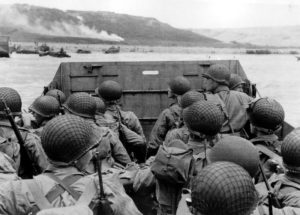
American troops watch activity ashore on Omaha Beach as their LCVP landing craft approaches the shore, Normandy, France June 6 1944
Source: US National Archives and Records Administration
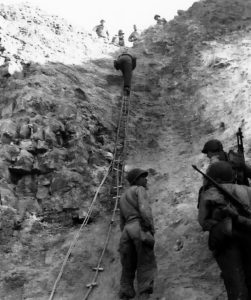
U.S. Army Rangers show off the ladders they used to scale the cliffs at Pointe du Hoc, Normandy, July 6 1944
Source: US National Archives and Records Administration
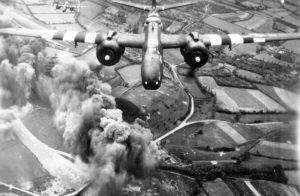
American A-20 Havoc bombers of U.S. 416th Bomb Group attack German road networks in Normandy, June 6 1944
Source: US National Archives and Records Administration
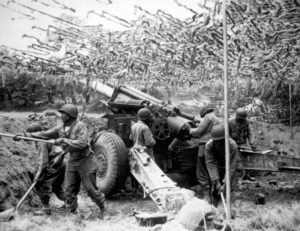
U.S. Army African-American soldiers set up a M114 155mm howitzer in France, June 28 1944
Photographer: Rothenberger
Source: US National Archives and Records Administration
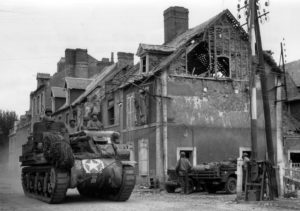
American 105mm M7 self-propelled artillery in Carentan, France, June 1944
Source: US National Archives and Records Administration
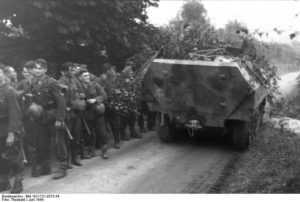
A camouflaged SdKfz. 251 armored halftrack passes a column of German troops, June 1944
Photographer : Theobald
Source: German Federal Archive
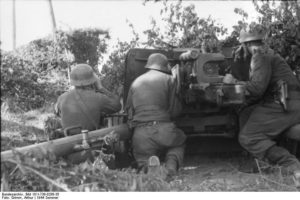
Camouflaged German 7.5cm PaK 40 anti-tank gun and it’s crew, June 1944
Photographer: Arthur Grimm
Source: German Federal Archive
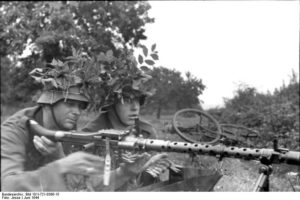
Two German soldiers with camouflaged helmets with a MG34 light machine gun, June 1944
Photographer: Jesse

